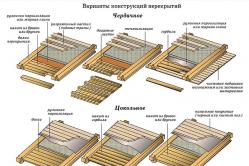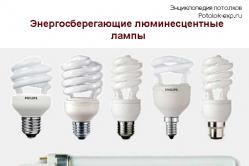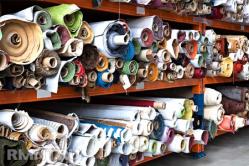Antipyretics for children are prescribed by a pediatrician. But there are situations of emergency care for fever, when the child needs to give the medicine immediately. Then the parents take responsibility and apply antipyretic drugs. What is allowed to give to infants? How can you bring down the temperature in older children? Which medications are the safest?
Spotlights due to a uniform distribution of the ceiling surface allow you to illuminate the entire room and furniture items that are in it. Other lighting fixtures, such as a chandelier or sconce, can not cope with this task. After all, they are installed in the central part of the ceiling. Since light will come from one point, the appearance of shadows is inevitable. Let's consider more details of a choice and installation of dot fixtures.
Point lighting elements are divided into several types. Distinguish:
- invoices;
- embedded models.
Instruments related to the first type are fixed using special elements - a clip. This allows you to install overhead spotlights on vertical and horizontal surfaces of brick, concrete or plasterboard. The decorative part of these devices is located outside, than they differ from the built-in elements. Such lamps look more massive, so they are not always suitable for use in small rooms. However, their main advantage is the extensive choice of design. Today, you can find overhead lamps with glass shades, decorated with various patterns, as well as with crystal pendants or decor in the form of leaves and flowers.
Built-in point lights are divided into several types. Distinguish:
- luminescent;
- lED Light;
- halogen devices.
Each of them differs in its operational properties. The main advantage of luminescent models is the energy-saving principle of operation. These lamps can save 80% of electricity compared to incandescent lamps. But choosing in favor of these lighting devices, it should be borne in mind that the lamps with which they are equipped contain mercury vapor. The concentration of this substance is very low, but care must be taken when working with these lamps.
The advantages of halogen appliances include environmental safety and long life. They radiate a bright, as close to natural light as possible. In addition, halogen models allow you to get a wide variety of colors. Characterizing the performance of these devices, one should also mention their specific shortcoming. Halogen lamps are not energy-saving. To save electricity with their help will not succeed. They can also be damaged by a voltage drop.

Point-by-point LED lamps for energy saving ahead of luminescent instruments. These models have glass or plastic diffusers. Under them are located LEDs, which provide lighting. LED devices can emit white light (it is divided into cold and warm glow) and colored (yellow, blue or red). They withstand voltage drops of up to 60 V. But these lamps are an order of magnitude more expensive than halogen and luminescent models.
Spotlights. A photo:



Features of the choice of mounting materials
- Lamps for spotlights should have a light reflecting layer in the lower part of the cap. In the process of purchase, you should check its availability.
- The power of the lamps should not exceed 40 W. In the opposite case, the ceiling structure will heat up, which will lead to its spoilage or to a fire.
- When choosing a cable, you should be guided by the material from which the ceiling is made. Gypsum cardboard has resistance to fire, so you can stay on a two-wire or three-core wire.
- Plastic and MDF do not have this property. To work with these materials, RKGM wires are selected that meet fire safety requirements. It's a copper incombustible cable. It consists of two layers:
- external is made of lacquered fiberglass material;
- internal - from a very strong silicone rubber. Such a wire is capable of withstanding temperature loads in the range from -60 ° C to + 180 ° C. It is used for rooms with a high level of humidity and sharp temperature changes, such as saunas and baths. Therefore, the fire safety of this cable can not be doubted.
- As connecting elements, terminal blocks are used, which can be purchased at a hardware store.
In the future, you need to double check the connection twice a year. There is a possibility of excessive heating of the contact area of the wires and terminal blocks. Avoid this situation can be with the help of copper lenses, which have acquired a reputation for more durable and reliable fasteners. The connection area is isolated using a special tape or shrink tube for this purpose.

How to arrange spotlights on the ceiling
The following materials are required for installation:
- spotlights;
- power wire;
- switch;
- lamps;
- insulation tape;
- the terminals or terminals where the wires are connected.
The installation process consists of several stages, the first of which is planning. Before the installation, you must decide on the location of the fixtures on the ceiling surface. This requirement is especially important for multi-level structures.
All levels are selected as separate lighting circuits. Fixtures should be located from each other at a distance of 1 m, and from the wall - 60 cm. They should be placed in such a way that does not affect the elements of the frame. Between the hole for the point devices and the nearest frame part, it is necessary to save a space of 30 mm. Otherwise, the structural profiles will prevent the fixing of the fixtures.
In the distribution process, you need to take into account other lighting devices installed on the ceiling. And also decorative elements. If all devices are planned to be used simultaneously, spot lights can be placed on the sides.

Distribution of spotlights
The next step is to distribute the wires. There are two types of accommodation:
- In accordance with the first, the fastening is performed during the installation of the frame. In this case, when installing luminaires, you simply drill holes, get wire loops and connect devices.
- If this procedure was lost during the installation, the cable is fed to the first hole, and the remaining wires are passed from one hole to the other. It is impossible to fix them on the frame elements. The wires will be located on the surface of the ceiling.
With the preliminary placement of the cable, it is laid along the route for the installation of point devices. At each point a bent wire loop of up to 15 cm is left. The fastening to the frame is done by means of plastic ties. In this case, the fastening elements do not need to be fixed very tightly, the wires must hang slightly. Since the cable has the property of changing its length at thermal exposure, this approach will prevent its spoilage. Then you can proceed to the roofing of the ceiling structure.

The procedure for preparing holes
The distribution of the luminaires on the surface of the ceiling is finished after the lining of the structure. In addition to the distance separating the devices from the frame elements, one must also take into account the location of the joints between the ceiling components. If the location of the luminaire coincides with the seam, it is moved to the central part of the strip.
To drill holes, use a crown to work with wood. With the help of this tool, grooves are also prepared for the sockets. The holes are absolutely straight, which contributes to the quality installation of lighting fixtures in plasterboard.
When determining the diameter should be guided by the fixtures. The hole must be 3 mm less than the outside of the instruments and not exceed the parameters of the inner part. In most cases this is 60-75 mm.

How to connect spot lights
- From the holes, you need to remove the loops of the pre-installed cable. In his absence, a different approach is used. From one hole to the other, two wires are laid. Work begins with the cable to which the power is connected. It must be remembered that before you start to connect, you must always disconnect the wire.
- Loops of the laid cable should be exposed, but before that they are cut in the bend area.
- To connect one lighting fixture, two 10 cm long wiring is required.
- The cable from each side is bare by 15 mm. One end of the short wiring is placed in the terminal, then clamped, the other is twisted with a cable that provides power.
- During connection, the marking on the lighting elements should be taken into account: PE corresponds to grounding, N - to zero, L - phase.

Method of attachment
On the sides of the spotlights for the ceilings are two clamps, through which the fixture is mounted. These parts should be bent in the upper direction to the stop and so put into the hole. It is important to pay attention to the wires, they should not fall under the hooks, which press the lighting elements to the ceiling and firmly fix them there.
After all luminaires are connected to the junction box and switch, the main power cable is connected. When using low-voltage LED devices, the wire is connected to a lowering power source. This concludes the work.

How to install spotlights on the suspended ceiling
To work with the tensioning structure, you will need a mortgage ring-shaped part. It can be purchased or manufactured in-house. This element must match the shape of the fixtures. This should be taken into account when working with triangular or square devices. For the production of the embedded part, it is necessary to prepare a dense material with a thickness of up to 6 mm, which can be easily processed and does not exfoliate. These requirements correspond to plastic.
Further installation work is carried out in the following order:
- Using a compass on the prepared material, you must draw a ring. Its diameter by 2 mm should exceed the size of the lighting device. The distance between the outer and inner radii is 25-30 mm.
- Then, using the jigsaw, the required part is cut according to the lines drawn.
- To fix the embedded element, use a U-shaped bracket. Its flexibility allows you to place the part on one level with the ceiling film. This can be done even after installation of the structure. First, the bracket is attached to the ring by means of screws.
- Then the whole construction is mounted with a dowel into the ceiling. All mortgage elements are manufactured and installed in this way.
- Now, in order to perform the installation of lighting equipment, it is necessary to cut holes in the film. It is important not to damage the ceiling.
- Before you start cutting out the holes, you need to stick a stopper to the film, the presence of which will help maintain its integrity. For this purpose, it is also necessary to prepare a ring. But this time you should use a material whose thickness does not exceed 1 mm, and the width corresponds to 10 mm.
- This ring should not go beyond the outer edges of the decorative lining of the lamp. It is fixed on the film with the help of super-glue over the hole of the embedded element.
- After 2-3 minutes, when the adhesive is started to act, a fragment of the film is cut inside the ring with a sharp knife.
- Then the wires are extracted from the hole, and the lighting fixtures are mounted in accordance with the same principle as when working with a false ceiling.
- When placing spotlights on a stretch ceiling, follow similar rules.

Conclusion
Point light fixtures differ in small parameters and consume a small amount of electricity compared with other fixtures. The process of their installation is quite simple. You can install these devices yourself on a suspended and stretched ceiling. Work with tension structures has some features. On such ceilings, special inserts of heat-resistant plastic must be installed in the mounting areas.
Mounting of spotlights:
The soul of any room is light, and the kitchen in this case is no exception. Perhaps you've already read my article, where you could get ideas for lighting the kitchen. Today's same article will be devoted to the rules of placing lamps relative to each other, as well as on working surfaces and countertops.
The rules for installing lamps in the kitchen
1. 30-40 centimeters - this is the distance on which to place the built-in ceiling spot, do not forget to retreat from the corner of the wall at least 20 centimeters to the spot.
2. Draw a diagram. Before you begin to work, indicate the location of the luminaires on a special scheme and note the distance to the walls. Light designers are advised to install a 20 Watt lamp per square meter of ceiling.

3. Do not neglect point lights,because they are needed for comfortable cooking in the kitchen. Spotlights can be integrated into the top cornice of kitchen cabinets or mounted in the lower panel. Pendant lights can also be used if you do not have cabinets on the wall, but there are open shelves. Take into account, from the bottom of the ceiling to the table top should be a distance of 70 to 87 centimeters.

4. Competently illuminate the dining tableusing luminaires on suspensions. For a round table, a pendant lamp with a diameter equal to half the width of the table is suitable, for an rectangular table, the optimum option is several hanging lamps at equal distances from each other. At the same time, it is necessary to move away from the edges of the table 30 centimeters, and to place the lamps at the resulting distance. As for the height of the fixtures, the lower edge of the suspended fixture should be placed at a distance of 70-90 centimeters above the table.

5. Do not ignore the highlight of the kitchen island.For these purposes, a group of spectacular hanging lamps can be used as well. The rules mentioned above also work for this group. The distance between the luminaires should not be less than 30-40 centimeters, and their height above the countertop should be 65-70 centimeters. When installing lighting over a kitchen island, consider that the light should not be the eye, and it is better to use lamps with cold light. It is best to cook under natural light.
So, what we have: a group of lamps above the kitchen island, a lighting of the dining table, spot lights, and built-in ceiling lights. All of them are located at the correct distance both from each other, and to the working surface.



